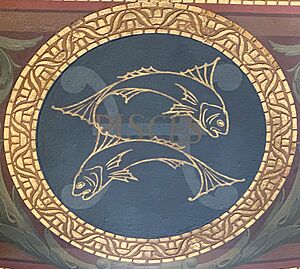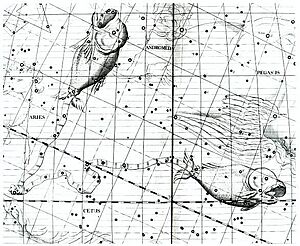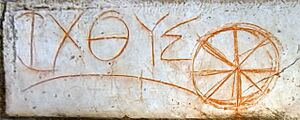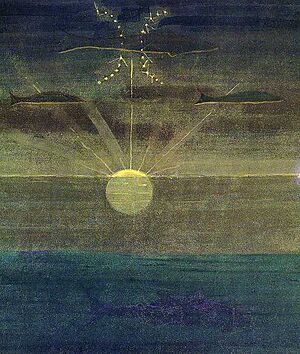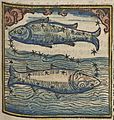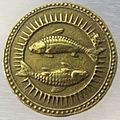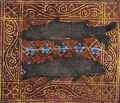Pisces (astrology) facts for kids
Quick facts for kids Pisces |
|
|---|---|
| Zodiac symbol | two fish |
| Duration (tropical, western) | February 18 – March 20 (2025, UT1) |
| Constellation | Pisces |
| Zodiac element | Water |
| Zodiac quality | Mutable |
| Sign ruler | Jupiter (traditional), Neptune (modern) |
| Detriment | Mercury |
| Exaltation | Venus |
| Fall | Mercury |
Pisces (♓︎), which means "fishes" in Latin, is the twelfth and final astrological sign in the zodiac. If your birthday is between February 19 and March 20, you are considered a Pisces. This sign is known as a mutable sign, meaning people born under it are often flexible and adaptable. The symbol for Pisces is two fish, which comes from an old story about fish helping the goddess Aphrodite.
Some astrologers believe we are currently in the Age of Pisces, while others think we are now in the Age of Aquarius.
Contents
Understanding the Pisces Sign
The astrological sign Pisces covers a specific part of the sky, from 330° to 360° of the zodiac circle. Even though the constellation of Pisces is in a slightly different spot in the sky today due to Earth's slow wobble (called precession), the astrological sign still uses its original 30-degree area.
The brightest star in the Pisces constellation is called Alpha Piscium, also known as Alrescha. This name comes from an Arabic word meaning "the cord" or "the well rope." This name fits well with the symbol of Pisces, which shows two fish tied together by a string.
The astrological symbol for Pisces shows two fish connected by a string, often by their mouths or tails. These fish are usually shown swimming in opposite directions. This represents the two sides of a Pisces person's nature. Pisces is ruled by the planet Jupiter, and in modern astrology, also by Neptune. It is a mutable water sign, which means people with this sign are often emotional, adaptable, and go with the flow.
Myths and Legends of Pisces
Many ancient stories and gods are linked to Pisces, including Poseidon (the Roman Neptune), Aphrodite, Eros, Typhon, Vishnu, and the Sumerian goddess Inanna.
Ancient Stories of the Fish
The word "Pisces" comes from the Latin word for "fishes." It is one of the oldest zodiac signs we know about. Pictures of the two fish have been found on an Egyptian coffin lid from around 2300 BC.
One famous Greek myth says that Pisces represents the fish that Aphrodite (also known as Venus) and her son Eros (also known as Cupid) turned into. They did this to escape a scary monster named Typhon. Typhon was sent by the goddess Gaia to attack the gods. Pan, another god, warned everyone and then changed into a goat-fish himself, jumping into the Euphrates River.
Another similar story says that an egg fell into the Euphrates River. Fish rolled it to the shore, and doves sat on it until it hatched. From the egg came Aphrodite. To thank the fish for their help, Aphrodite placed them in the night sky as the Pisces constellation. Because of these myths, the Pisces constellation was also known by names like "Venus and Cupid" or "Mother of Venus."
Pisces in Modern Times and Religion
The Jewish holiday of Purim happens around the full moon that comes before Passover.
Astrological Ages
An astrological age is a long period of time in astrology that matches big changes in human culture, society, and politics. There are twelve astrological ages, one for each zodiac sign. These ages happen because of a slow wobble of the Earth called the precession of the equinoxes. One full cycle of this wobble takes about 25,920 years.
The Age of Pisces is believed to have started around 1 AD and is expected to end around 2150 AD. Many people connect the birth of Christ with the start of this age. Because of this, many Christian symbols for Christ use the astrological symbol for Pisces, the fish. Christ himself is often seen as having many traits of a Pisces. The twelve apostles were called "fishers of men," and early Christians sometimes called themselves "little fishes." A secret word for Jesus was "ΙΧΘΥΣ ICHTHYS", which is the Greek word for fish. The start of the Age of Pisces is often seen as the beginning of the Christian religion. Saint Peter is sometimes seen as the apostle connected to the Piscean sign.
Pisces in Art
Pisces has appeared in many works of art throughout history. In the first part of Dante's famous poem Purgatorio, Venus in Pisces represents divine love. Pisces is also featured in Luca Della Robbia's 15th-century artwork called Plate with the Month of February. The sign is also the subject of a poem by Elizabeth Barrett Browning:
And here fantastic fishes duskly float,
Using the calm for waters, while their fires
Throb out quick rhythms along the shallow air.—Elizabeth Barrett Browning, A Drama of Exile
Images for kids
-
Appearing in Chartres Cathedral in Chartres
-
16th-century woodcut by Johannes Regiomontanus
-
Pisces on "Wishing Bridge" in Old Jaffa, Tel Aviv, Israel
-
Depicted in a 14th western British Book of Hours
See also
 In Spanish: Piscis (astrología) para niños
In Spanish: Piscis (astrología) para niños
- Astronomical symbols
- Chinese zodiac
- Circle of stars
- Cusp (astrology)
- Elements of the zodiac


